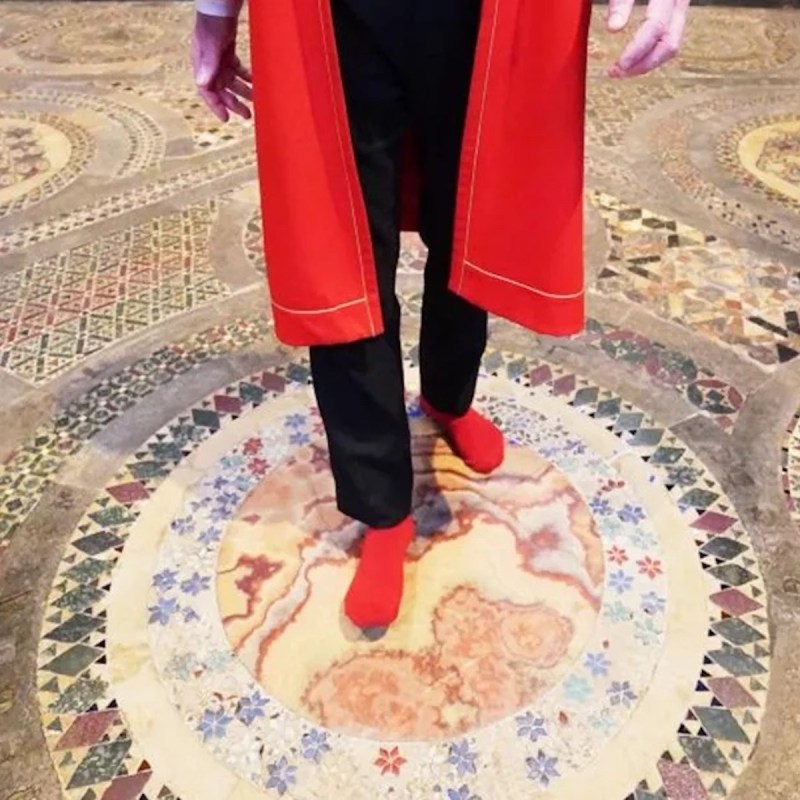
Historic Westminster Abbey in London is about to offer visitors a chance to do something they’ll always remember, but if you want to go, there is a catch. You’ll need to make sure your socks don’t have holes.
Videos by TravelAwaits
After King Charles III’s coronation on May 6, visitors who remove their shoes will be able to stand in the spot where he was crowned. That spot, by the way, is where every coronation since 1066 has been held.
The section of the Abbey’s floor where the chair is placed when Britain’s monarchs are crowned is known as Cosmati pavement. It had fallen into disrepair and was consequently covered by carpets for decades. However, a 2-year conservation project that restored the floor was completed in 2010.
After King Charles III’s coronation, the area, which is normally roped off and closed to visitors, will be open to small guided “barefoot tours.” Visitors will be asked to remove their shoes to avoid wear and tear on the restored floor.
“Standing on the pavement and feeling that sense of awe of being in the central part of the Abbey is a really amazing experience,” said Scott Craddock, head of visitor experience at Westminster Abbey, according to the Associated Press. “It will give people the opportunity to feel what it’s like being at that center stage of the coronation.”
So, what’s so special about Cosmati pavement? King Henry III commissioned the mosaic in the 1200s. Made of marble, stone, glass, and metal by Italian craftsmen and English masons, the mosaic is believed to be the best surviving example of this type of stonework outside of Italy. It gets its name from the Italian Cosmati family that created this type of stonework.
“It’s a unique piece of art to Westminster Abbey but also to Britain itself — there are no other mosaic pavements like this in the UK,” said Vanessa Simeoni, the Abbey’s head conservator, the Associated Press continues.
The Abbey will offer tours guided by experts on some days from May 15–July 29.
What Is Westminster Abbey?
Westminster Abbey has been the coronation church since 1066, the History of Westminster Abbey explains. It’s also the final resting place of more than 3,000 important Britons and it has been used for numerous royal occasions, including 16 royal weddings.
It is also a dedicated place of worship that is still in use.
Westminster Abbey — or as it is formally known, the Collegiate Church of St. Peter, Westminster — is neither a cathedral nor a parish church. Instead, it is a “Royal Peculiar” that is subject only to the sovereign and not to an archbishop or bishop.
“In the 1040s, King Edward (later St. Edward the Confessor) established his royal palace by the banks of the River Thames on land known as Thorney Island,” the History of Westminster Abbey continues. “Close by was a small Benedictine monastery founded under the patronage of King Edgar and St. Dunstan around 960 A.D. This monastery Edward chose to re-endow and greatly enlarge, building a large stone church in honor of St. Peter the Apostle. This church became known as the ‘west minster’ to distinguish it from St. Paul’s Cathedral (the east minster) in the City of London.”
Then, in the 13th century, King Henry III decided to rebuild the Abbey in the new Gothic style of architecture. Westminster Abbey was designed to be not only a monastery and place of worship, but also a place for the coronation and burial of monarchs.
Interestingly, every monarch since William the Conqueror has been crowned in the Abbey, except for Edward V and Edward VIII who were never crowned.
There are around 3,300 people buried, commemorated, or both at Westminster Abbey, including scientist, mathematician, and astronomer Sir Isaac Newton, who is buried there. The funeral for scientist and writer Charles Darwin was held there and a bust now stands in memorial; a memorial stands for poet and novelists Charlotte, Emily, and Anne Brontë; and a statue stands in memorial for Dr. Martin Luther King Jr.
How To Visit Westminster Abbey
You can learn more about visiting Westminster Abbey online and take the Westminster Abbey virtual tour.
If you can’t make the journey to London, there’s still a way to “experience 1,000 years of history and find out more about the Abbey without leaving home,” by taking a virtual tour, the Abbey explains.
Be sure to also read our London content, including:
